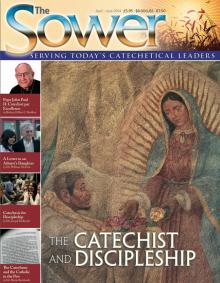As a preacher and teacher of the faith, there is none better than the late Pope John Paul II. His spoken and written words on the entire spectrum of Catholic doctrine fill many volumes. John Paul was seen and heard by more people throughout the world than St. Paul and all twelve apostles together. He spoke in language that ranged from the sophisticated cadence of encyclical letters to the folksy language of general audiences. In his four volumes on The Creed he offers the following thoughts for the benefit of all who teach Christian doctrine.
We see from the Gospels how Jesus himself adapted his teaching to his listeners. Most of his parables are simple stories that convey a rather obvious point. Other of his parables are more sophisticated, intended for those who resisted him and his teaching, such as the Pharisees. Jesus did not expect the people to understand and accept the full content of his teaching at once. In fact, at the beginning of his public life he cautioned people not to publicize his miracles. To do so prematurely, before they could be seen in the context of his total message, would lead to confusion. They would take him to be a wonder-working genie whose purpose was to alleviate all human needs and sufferings, or perhaps as a political leader who would throw off the yoke of the Roman Empire and restore the glory of the ancient Israelite kingdom of David and Solomon. The idea of a suffering Messiah would be completely beyond their comprehension, yet this is an essential part of the Gospel message.
We are dealing with variables here. One is the human element: the intellect and its ability to understand—an ability that varies with an individual’s competency and age. The other is faith, a supernatural gift that is given at God's own discretion in ways and degrees that we cannot possibly understand, but to which we must be open. That openness itself is another variable.
Educational theory offers techniques for dealing with the human element in understanding and helps in the teaching of religion. Doctrine should be taught in consideration of the age and capacity of the student. However, the teacher or preacher must be careful that, while adapting the technique of teaching to the capacity of the student, he or she does not alter the content of faith itself. People sometimes complain that some subjects are never mentioned from the pulpit. Could it be because these subjects are sensitive and some priests fear that addressing them will repel people?
We might consider Jesus’ own handling of sensitive material. Consider his famous Discourse of the Bread of Life (Jn. 6). He tells the people that, unless they eat his flesh and drink his blood, they would have no life in them—meaning eternal life. Many, even disciples, leave and no longer follow him, because they cannot accept it. Yet Jesus does not back down, nor does he water down his teaching. They must take it as it is.
Our Lord did not call back the people that left and offer to tell it differently so that they would be more receptive. In effect, he “drew a line in the sand,” beyond which they could not retreat without rejecting him. He let them leave. Then he asked the apostles, “Will you too, leave me?” Peter answered correctly, “To whom shall we go, Lord? You have the words of eternal life!”
John Paul II referred to new methods of teaching and means of communication—using audio-visual technology, for example. While some lessons can be taught to techno-savvy youngsters, some doctrines, however, do not adapt themselves well to these technical devices. Grace, the soul, God himself cannot be shown in Power Point presentations. Like all tools, these technological devices must be used with skill and with understanding of both their potential and their limitations.
In his Apostolic Exhortation, Catechesi Tradendae, the pope highlights three characteristics of proper catechetical teaching: 1) it must deal with essentials, without any claims to tackle all disputed questions or to transform itself into theological research or scientific exegesis; 2) it must nevertheless be sufficiently complete, not stopping short at the initial proclamation of the Christian mystery (the kerygma); 3) it must be an integral Christian initiation, open to all the other factors of Christian life.
Further, “the spirit of faith is essential to every Christian catechesis.” That faith must first and foremost fill the teacher, preacher, or catechist. Scientific methods and pedagogy will not make up for a lack of faith. “It is faith that pushes the catechist to seek the best method for explaining and transmitting doctrine. It is faith that forms the soul of catechesis and inspires every effort at pedagogy in religious teaching.”
The late pope spoke of the importance of training catechists and religion teachers. Our Lord seems to have spent more time with his apostles than with the crowds. Part of their formation was simply being with Jesus himself. For today’s catechist, that means the cultivation of one's own spiritual life as a way of “being with Jesus.” More important than communicating doctrines is the communication of faith itself. That is the true task of the catechist or missionary. That communication is closely bound up with the example of Christian living that the teacher displays.
This article is originally found on page 7 of the printed edition.
This article is from The Sower and may be copied for catechetical purposes only. It may not be reprinted in another published work without the permission of Maryvale Institute. Contact [email protected]

















